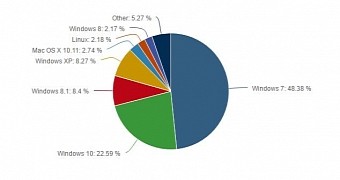Windows 10 is no longer available as a free upgrade for Windows 7 and 8.1 users and this seems to be impacting its adoption more than even Microsoft expected, with new data revealing just a slight market share improvement in October 2016.
NetMarketShare puts Windows 7 on the leading spot last month with a market share of 48.38 percent, while Windows 10 is the runner-up with 22.59 percent.
Windows 8.1 is third with 8.40 percent, followed by Windows XP and Mac OS X 10.11 with 8.27 and 2.74 percent, respectively.
And while at first glance this seems to be decent performance for most Windows versions, not the same thing can be said after looking at their figures compared to the previous months.
How each Windows version performed last month
First of all, leader Windows 7. At this point, this OS version is installed on 48.38 percent of the PCs, which is quite impressive given the fact that it was launched in 2009 and Microsoft pushed so hard for Windows 10 adoption. This is a small increase over the 48.27 percent market share it had in September.
Windows 10, on the other hand, posted an increase of just 0.06 percent from 22.53 percent in September and still below 22.99 percent in August. This means that Windows 10 is still below the record market share it reached three months ago when Microsoft pushed the Anniversary Update to users.
The best news this month is that Windows XP is declining at a much faster pace, with this data showing a substantial drop from 9.11 percent in September to 8.27 percent last month. This is the lowest Windows XP ever got since it reached end of support in April 2014, and users might be finally making the transition to newer versions of Windows.
It goes without saying that Microsoft has no reason to be pleased with the small growth posted by Windows 10, but there’s still hope that the enterprise migration to the new OS would help push the new OS closer to Windows 7. Truth be told, Microsoft really needs this to happen because Windows 7 reaches end of support in 2020 and unless Windows 10 grows at a faster rate, there’s a good chance that Microsoft would experience another Windows XP moment when users refuse to migrate.

 14 DAY TRIAL //
14 DAY TRIAL //